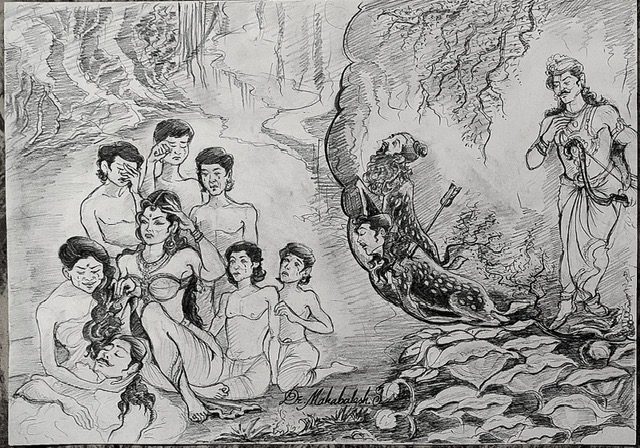B. Sadananda Naik
Karnataka, India

The Mahabharata is one of two great ancient Indian Sanskrit epics of Hinduism. It narrates the struggle between two groups of cousins in the Kurukshetra War, the Kaurava and Pandava princes. Maharaja Pandu, father of Pandavas, is one of the key figures in this epic.
In the story, the premature death of King Vichitravirya of Hastinapura compelled Queen Sathyavathi to approach her elder son Vyasa to impregnate Ambalika, one of Vichitravirya’s widows, by way of niyoga, a well-accepted social practice in those days in India. When Ambalika saw Vyasa, she was disgusted, and she later gave birth to a pale baby, who was named Pandu (“pale”). However, Pandu grew up to be a strong warrior and excellent archer. He became king of the Kuru kingdom and conquered additional territories to increase the size of his empire.1
While hunting one day, Maharaja Pandu shoots arrows at a couple of deer in the process of coitus. But the deer are in fact Sage Kindama and his wife in disguise. The dying sage curses King Pandu, telling him that whenever “he approaches his wives with the intent of having sex, he would die instantaneously.”1
As a consequence of Kindama’s curse, Pandu becomes incapable of fathering children. However, he becomes a foster father to five Pandavas with the help of a divine childbearing mantra possessed by his wife, Kunti. One day while wandering in the forest, Pandu becomes captivated by the beauty of Madri, his second wife, and is filled with lust for her. Despite Madri’s pleas, he engages in sexual intercourse with her and dies instantaneously, as per the sage’s curse.1
With the description of a pale complexion from birth with no other physical or mental comorbidities, Maharaja Pandu may hypothetically have had albinism. Oculocutaneous albinism is an autosomal recessive condition caused by absent or decreased melanin biosynthesis.2 Except for vision problems, most people with albinism are healthy. This was evident in the case of King Pandu, who excelled as a great warrior.
Applying modern medical knowledge to the epic character of Pandu, there are several possible diagnoses that could cause sudden death during sexual intercourse. Sexual intercourse may provoke intracerebral hemorrhage, especially subarachnoid hemorrhage.3 But with no prior history of headaches, vomiting, seizures, or loss of consciousness, this is less likely in the case of Pandu. There has been at least one report of sudden cardiac death in a person with albinism due to Takayasu’s arteritis, a rare inflammatory condition of large blood vessels. But Pandu had not suffered any physical limitations and led an active life, making this possibility unlikely, even if he had albinism.4 Another cause of sudden death in a healthy person during strenuous activity is hypertrophic obstructive cardiomyopathy, or HOCM. This is a diverse clinical and pathophysiologic disorder of unknown cause that results in asymmetric or concentric hypertrophy of the left heart ventricle. HOCM is a significant cause of sudden cardiac death in young people during strenuous physical activity, including well-trained athletes. Sexual intercourse led to sudden cardiac death in at least one study of individuals with this condition.5 Arrhythmogenic cardiomyopathy is another inherited heart muscle disorder that predisposes young people and athletes to sudden cardiac death. But these individuals usually have previous episodes of exercise-induced palpitation or syncope. However, sexual intercourse may be sufficient to trigger a fatal arrhythmia in individuals with this condition as well.5,6
Maharaja Pandu, from descriptions in the Mahabharata, likely would have had albinism, an autosomal recessive condition. His sudden demise during sexual intercourse might be attributed today to an undiagnosed cardiac condition such as hypertrophic obstructive cardiomyopathy or arrhythmogenic cardiomyopathy.
References
- The Mahabharata of Krishna-Dwaipayana Vyasa. Translated into English Prose [Adi Parva, Sections CVI, CXVIII, CXIX of Sambhava Parva], Bharata Press, Calcutta,1884. Available at https://en.wikisource.org/wiki/Page:The_Mahabharata_of_Krishna-Dwaipayana_Vyasa_(1884).djvu/7
- Marçon CR, Maia M. “Albinism: epidemiology, genetics, cutaneous characterization, psychosocial factors.” Ann Bras Dermatol. 2019 Sep-Oct;94(5):503-520. doi: 10.1016/j.abd.2019.09.023. Epub 2019 Sep 30.
- Braun CT et al. “Death after Sexual Intercourse.” Case Rep Emerg Med. 2015;2015:646438. doi: 10.1155/2015/646438. Epub 2015 Dec 1.
- Said SA et al. “Takayasu’s arteritis: a rare cause of cardiac death in a Caucasian teenage female patient.” Neth J Med. 1997 Nov;51(5):182-6. doi: 10.1016/s0300-2977(97)00052-1.
- Finocchiaro G et al. “Association of Sexual Intercourse With Sudden Cardiac Death in Young Individuals in the United Kingdom.” JAMA Cardiol. 2022 Mar 1;7(3):358-359. doi: 10.1001/jamacardio.2021.5532.
- Corrado D et al. “Arrhythmogenic cardiomyopathy.” Circulation Research 121.7 (2017): 784-802.
DR. B. SADANANDA NAIK, M.D., is a senior physician at Alva’s Health Centre in Karnataka, India.

Leave a Reply